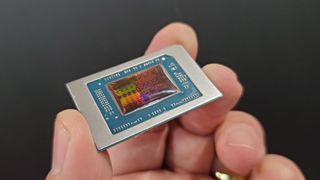Well, it's finally here. We've been crossing our fingers for a long, long time waiting for AMD Strix Halo, and now the waiting's over. As one of its many rabbit hat-pulls for CES 2025, AMD's just announced the halo (ie, top) end of its Strix Point mobile processors, combining Zen 5 CPU cores, RDNA 3.5 integrated graphics, and an NPU.
These new "halo" processors are the Ryzen AI Max 385, AI Max 390, and AI Max+ 395. (Oh, and the AI Max 380, but that's a Pro-only, ie, business-focused, processor.) These will be available Q1-Q2 2025.
We've suspected a Strix Halo launch for a while now, and we'd heard about its AI Max naming and possible specs since September last year. As it turns out, those previously rumoured specs were almost entirely accurate. The only difference is that now we know the Ryzen AI Max 390 will have just 32 CUs, not 40 as the previous rumour had it. That number of CUs is the privilege of the top-end Max+ 395 alone.
Here's the full range of specs:
Swipe to scroll horizontally
| Ryzen AI Max+ 395 (and Pro) | 16 / 32 | 40 | 5.1 GHz | 80 MB | 50 | 45–120 W |
| Ryzen AI Max 390 (and Pro) | 12 / 24 | 32 | 5 GHz | 76 MB | 50 | 45–120 W |
| Ryzen AI Max 385 (and Pro) | 8 / 16 | 32 | 5 GHz | 40 MB | 50 | 45–120 W |
| Ryzen AI Max 380 (Pro only) | 6 / 12 | 16 | 4.9 GHz | 22 MB | 50 | 45–120 W |
If you're wondering just how powerful those 40 RDNA 3.5 CUs on the AI Max+ 395 will be, bear in mind the Z1 Extreme found in the Asus ROG Ally X and a couple of other handhelds has just 12 RDNA 3 CUs, which are very similar in architecture. Even in the AI Max 385 and 390, you're getting close to three times the graphics capabilities of such handhelds.
But these AI Max chips probably won't be for handhelds—what use would a handheld have for so many CPU cores plus an NPU? Instead, AMD is explicitly targeting these chips at the laptop market, especially for creative and AI workloads.

This is in part thanks to its "unified coherent memory architecture" which allows up to 96 GB of memory to be dedicated to graphics, with a bandwidth of 256 GB/s. Such bandwidth, AMD says, is "unprecedented in any x86 mobile device". Ultimately, all of this combined with the NPU means AI Max chips can run large AI workloads with "performance faster than high-end desktop graphics cards".
AMD backs up these claims with its own graphs—which we should, of course, take with a pinch of salt. Comparing the top-end AI Max+ 395 to the Intel Core Ultra 9 288V, AMD claims 1.4x faster graphics performance and 2.6x faster rendering (including a whopping 402% faster performance in Blender Classroom). And it even seems to trade blows with, or beat, Apple M4 chips for rendering.
We can obviously expect good things for gaming, too, compared to other systems with integrated graphics. For context, we found the 16-CU 890M to have modern games playable at 1080p, and these new AI Max processors will have at least double the CUs of that mobile GPU.
That's why I certainly take the AMD representative seriously when they say it is "simply the most advanced mobile x86 processor ever created". The only question is price and target market.
I don't, unfortunately, see these AI Max chips being the best options for gaming. They'll be a dab hand at gaming, for sure, but they'll surely be expensive given their overall feature set that will be beneficial for creative professionals and graphics/AI developers.
In which case, I'd suspect we'd get more gaming bang for our buck from gaming laptops with dedicated mobile GPUs in them. Then again, Strix Point is lower power than a fully fledged gaming chip and GPU combo, so maybe the battery life will justify the likely premium cost. We'll have to wait and see.

 1 week ago
10
1 week ago
10









 English (US) ·
English (US) ·